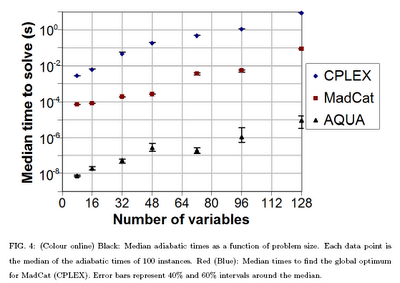

| Visitors Now: | |
| Total Visits: | |
| Total Stories: |

| Story Views | |
| Now: | |
| Last Hour: | |
| Last 24 Hours: | |
| Total: | |
Investigating the Performance of an Adiabatic Quantum Optimization Processor
From
Arxiv – Investigating the Performance of an Adiabatic Quantum Optimization Processor (14 pages) A paper discusses the performance of Dwave systems adiabatic quantum computer. This is based upon the 128 qubit system. Dwave has had a 512 qubit chip for nearly 1 year. Performance for the adiabatic quantum computer will vary by the problem and the algorithm, but for one class of problem they were seeing a speedup of 1000 times for the 512 qubit chip versus the 128 qubit. The 512 qubit chip can also handle larger problems.
Adiabatic quantum optimization offers a new method for solving hard optimization problems. In this paper we calculate median adiabatic times (in seconds) determined by the minimum gap during the adiabatic quantum optimization for an NP-hard Ising spin glass instance class with up to 128 binary variables. Using parameters obtained from a realistic superconducting adiabatic quantum processor, we extract the minimum gap and matrix elements using high performance Quantum Monte Carlo simulations on a large-scale Internet based computing platform. We compare the median adiabatic times with the median running times of two classical solvers and fi nd that, for the considered problem sizes, the adiabatic times for the simulated processor architecture are about 4 and 6 orders of magnitude shorter than the two classical solvers' times. This shows that if the adiabatic time scale were to determine the computation time, adiabatic quantum optimization would be signi ficantly superior to those classical solvers for median spin glass problems of at least up to 128 qubits. We also discuss important additional constraints that a ffect the performance of a realistic system.
See more and subscribe to NextBigFuture at 2012-08-31 18:12:42 Source: http://nextbigfuture.com/2012/08/investigating-performance-of-adiabatic.html
Source:



